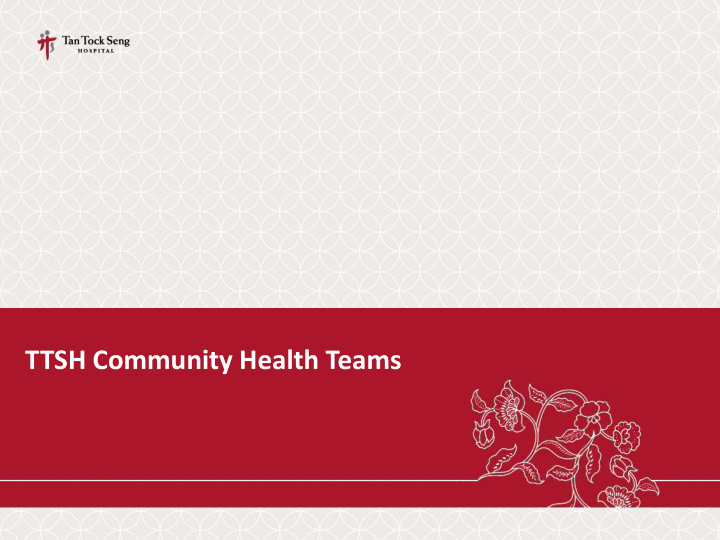



TTSH Community Health Teams
Our Journey in Managing Frequent Admitters Aged Care Transition • Complex care coordination • Ease transitions of patients back to the community and prevent readmissions 2012 2018 Transitional Care Service Post-Acute Care @Home • Single-point-of-contact to coordinate • Rehabilitate and monitor patients the care plan of patients with with assessed clinical or nursing need complex care needs • post-discharge Support safe and coordinated • transitions from the hospital to the Promote caregiver competence in managing homebound patients community and home Community Health Teams Virtual Hospital • Population health focus • Targeted at frequent admitters (FAs) i.e. has 3 or more admissions in the • Managing the pre-frail to frail past 1 year 2008 2016 • Reduce unnecessary hospital bed days and emergency attendances
Transitional Care within the RHS Tripartite Framework for Care Coordination The TTSH Community Health Team works closely with Community Partners , who will help the patient navigate the services in the community, and also establish GP & Primary Care support for the patient. Well Primary Care Illness Polyclin FMC ics ACTION ACTION CC P1 Community VH Health GP Crisis Manager Health Team P2 PACH Frailty Community Community Partners Health Team PATIENT Dying Well
Why the Move Towards Population Health? CENTRAL ZONE DEMOGRAPHICS % Population ≥65 Yrs Central, 65y & Oldest Population of 17% aged 65y & Above Above, 17 (13% Nationally) Yishun, 65y & Above, 10 53% of Inpatients aged 65y & Above Woodland s, 65y & (29% Nationally) Central Above, 8 Yishun Largest Population Catchment of 1.4M Woodlands (26% of 5.54M)
ROLE OF COMMUNITY HEALTH To ensure and maintain the well ll-being of the Cen Central Health res resid ident popu population , keeping them well in the community and minimizing healthcare resource utilization. 3 Aspects of Well-Being • Health • Social Ang ng Mo Ki Kio • Mental Houga gang Sera erango goon Bish shan Toa oa Payo yoh Our Three-Pronged Strategy • Service provision • Collaboration Geyl Ge ylang • Activation No Nove vena-Kallang- Ro Roch chor or - Primary Care* - Community Partners* - Activated Residents* *Note: Locality-Based NHG Central Zone
The Community Health Framework (within Sub-Zones) Hospital CRISP Community Primary Care Networks Empanelment ED PRIMARY CARE PARTNERS Inpatient SOC • GPs • FMCs • Polyclinics Primary Care Discharges • CHA Activated Residents COMMUNITY HEALTH TEAM The Community Health Comm. Care Prog. Eco-System Comm. Nursing/ H2H Community-Based Institution-Based • SGA • CHs • CNS • NHs • CHPs • Hospices • VWOs Project Dignity Value Stream COMMUNITY Mapping and Programme IMPACT PARTNERS Process Improvement Project Care
What We Hope to Be Different With Community Health Hands off means a change in MY OUR primary provider in a Community Patient Patient Of Providers Understand the needs of the “ENROLLED” WHOLE current unenrolled ; think of how Population Population to meet these needs Centre is our “base”; but care delivery can be anywhere CENTRE COMMUNITY To understand the different ways Focused Focused of affecting the environment & its occupants Shifting of focus: Meeting ALL Delivery of Needs in From services provided by TTSH to SPECIFIC Integrative how we can work together to meet Services Ways all needs in a coordinated manner
Community Health Team Bu Building re rela latio ionship ips and wor workin ing wi with loc ocal part rtners across health care and social care domains to enable healt lth engagement , care re coo oordi rdinatio ion and ageing-in in-pla lace . 7 Place-based, multi- disciplinary* teams embedded in each zone *Comprising doctors, nurses, allied health professionals, pharmacists and medical social workers
Community Health Team OBJECTIVE OF THE COMMUNITY HEALTH TEAMS To build re rela latio ionship ips and wor work wi with th loc ocal partn rtners across health care and social care domains to enable healt lth engagement , care re coo oordi rdinatio ion and ageing-in in-pla lace . Primary focus of Community Health Teams Delay Frailty Progression Empowering Self- Management of Case Management Management of Health Acute Medical Issues Conditions Activation Service Provision Collaboration • Risk assessments • • • Case management Co-creation of programmes Case discussions • • • Co-learning of best practices Coaching, education, counselling Co-management • • • Create activated communities Promoting self-empowerment Care transitions • Bridging interventions
Community Health Team Bu Building re rela latio ionship ips and wor workin ing wi with loc ocal part rtners across health care and social care domains to enable healt lth engagement , care re coo oordi rdinatio ion and ageing-in in-pla lace . Ho How Our r Tea eams Work Direct Service Provision Collaboration & Activation • Home visits • Development of interest-based programmes for residents • Telephone reviews • Falls screening with partners • Site clinic reviews at Community • Group education and coaching Health Posts • Training for partners
Referral form
THANK YOU
Recommend
More recommend